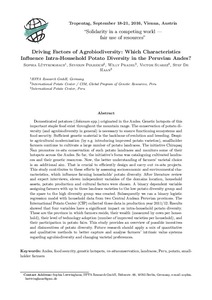Domesticated potatoes (Solanum spp.) originated in the Andes. Genetic hotspots of this important staple food exist throughout the mountain range. The conservation of potato diversity (and agrobiodiversity in general) is necessary to ensure functioning ecosystems and food security. Sufficient genetic material is the backbone of evolution and breeding. Despite agricultural modernisation (by e.g. introducing improved potato varieties), smallholder farmers continue to cultivate a large number of potato landraces. The initiative Chirapaq Nan promotes in-situ conservation of such potato landraces and monitors some of their hotspots across the Andes. So far, the initiative’s focus was cataloguing cultivated landraces and their genetic resources. Now, the better understanding of farmers’ varietal choice is an additional aim. That is crucial to efficiently design and carry out in-situ projects. This study contributes to these efforts by assessing socioeconomic and environmental characteristics, which influence farming households’ potato diversity. After literature review and expert interviews, eleven independent variables of the domains location, household assets, potato production and cultural factors were chosen. A binary dependent variable assigning farmers with up to three landrace varieties to the low potato diversity group and the spare to the high diversity group was created. Subsequently we ran a binary logistic regression model with household data from two Central Andean Peruvian provinces. The International Potato Center (CIP) collected these data in production year 2011/12. Results showed that four variables have a significant impact on intra-household potato diversity. These are the province in which farmers reside, their wealth (measured by cows per household), their level of technology adoption (number of improved varieties per household), and their participation in potato fairs. This study provides an overview of possible incentives and disincentives of potato diversity. Future research should apply a mix of quantitative and qualitative methods to better capture and analyse farmers’ intrinsic value systems regarding agrobiodiversity and changing varietal preferences.
Driving factors of agrobiodiversity: which characteristics influence intra-household potato diversity in the peruvian Andes?.
Citation: Luttringhaus, S.; Polreich, S.; Pradel, W.; Suarez, V.; Haan, S. de. 2016. Driving Factors of Agrobiodiversity: Which Characteristics Influence Intra-Household Potato Diversity in the Peruvian Andes?. Solidarity in a competing world-fair use of resources. Vienna (Austria). 18-21 Sep 2016 . Vienna (Austria). 1 p.
2017-07-03
POTATO AGRI-FOOD SYSTEMS, POTATOES,
SOUTH AMERICA
PERU
conference_paper_abstract

